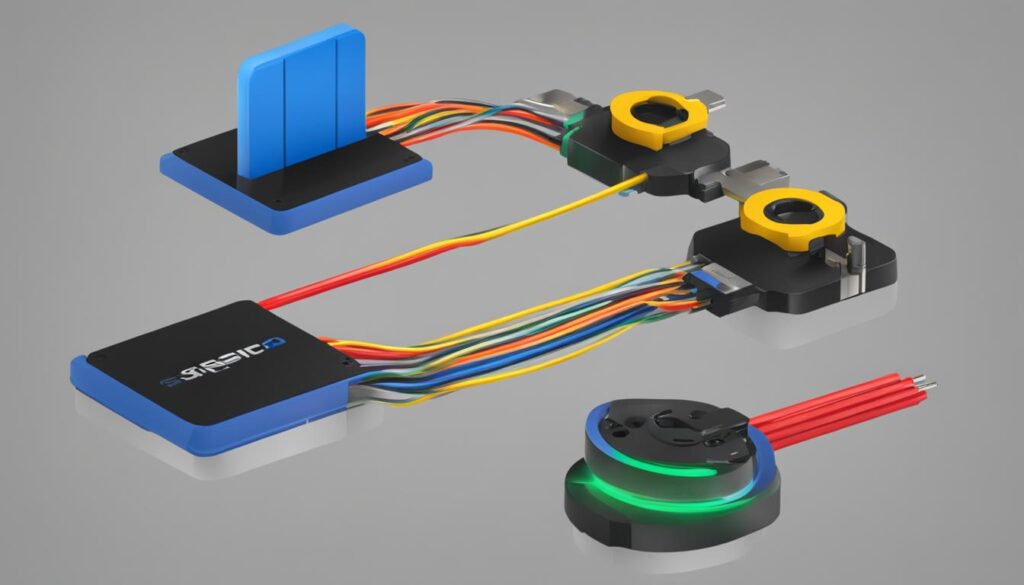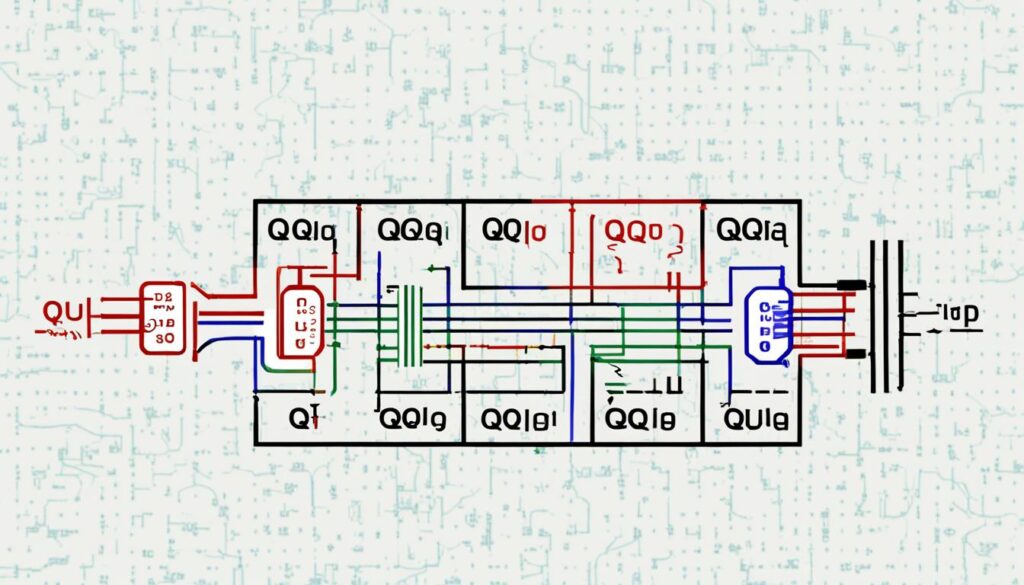Welcome to our article on the SR flip-flop, a key component in digital circuits. In this section, we will provide you with a brief introduction to this important element and its role in digital circuit design.
The SR flip-flop, also known as the Set-Reset flip-flop, is widely used in digital circuits for memory storage and logic operations. It allows us to store and manipulate binary information, making it essential in the field of digital electronics.
Understanding the concept of flip-flops in digital circuits is crucial for anyone involved in electronics engineering. Flip-flops are sequential circuits that can maintain their output state until changed by a controlling input signal.
Flip-flops come in various types, each with its specific characteristics and functionalities. The SR flip-flop is one such type that offers distinct advantages in certain applications.
In the following sections, we will dive deeper into the fundamentals of the SR flip-flop, exploring its construction, working principle, and applications. We will also discuss its advantages and limitations to provide you with a comprehensive understanding of this vital digital circuit component.
Table of Contents
Understanding Flip-Flops in Digital Circuits
Flip-flops are crucial components in digital circuits, playing a vital role in storing and manipulating binary information. These versatile circuits are essential for the operation of various digital systems, ranging from simple logic gates to complex microprocessors.
Flip-flops are designed to retain and remember information, enabling sequential logic and memory storage capabilities. They are capable of storing a single bit of information, represented by 0 or 1, and can retain this value until the next input is received.
There are several types of flip-flops commonly used in digital circuits, each with its own unique characteristics and applications. Some of the most popular types include:
- SR Flip-Flop: The Set-Reset flip-flop is one of the simplest types, allowing users to set and reset its output based on specific input conditions. It is commonly used in applications that require memory storage and state control.
- JK Flip-Flop: The JK flip-flop is an enhanced version of the SR flip-flop, offering additional functionalities such as toggling and holding states. It is widely used in applications that require more complex sequential logic operations.
- D Flip-Flop: The D flip-flop, also known as the data flip-flop, is capable of storing a single bit of data. It has a single data input and a clock input, making it ideal for synchronous systems.
- T Flip-Flop: The T flip-flop, also known as a toggle flip-flop, can change its output state with each clock cycle if the “T” input is high. It is commonly used in applications that require frequency division and counting.
Each type of flip-flop operates based on specific input conditions and exhibits unique characteristics that make it suitable for different applications. Understanding the functionalities and behaviors of different flip-flops is essential for designing efficient digital circuits.
Examples of Flip-Flop Applications
Flip-flops find extensive applications in digital systems, contributing to various functionalities. Here are a few examples:
- Memory units in computers and microcontrollers, storing data and instructions.
- Counters and timers in electronic devices, enabling precise timekeeping and event tracking.
- Registers in digital signal processors, facilitating data storage and manipulation.
- State machines in control systems, allowing for complex system control and decision-making.
By utilizing different types of flip-flops, designers can create sophisticated digital circuits that perform a wide range of tasks, from arithmetic operations to real-time data processing.
The Fundamentals of SR Flip-Flop
In this section, we will delve deeper into the SR flip-flop, understanding its construction, logic diagram, and truth table. We will explore the set and reset inputs, as well as the corresponding output behavior.
Construction of SR Flip-Flop
The SR flip-flop is constructed using two NAND gates. The output of each NAND gate is connected to the input of the other NAND gate, creating a feedback circuit. This cross-coupling arrangement forms the basic structure of the SR flip-flop.
Logic Diagram of SR Flip-Flop
The logic diagram of the SR flip-flop depicts its internal connections and shows how the inputs and outputs are related. It consists of two NAND gates with feedback connections. The set (S) and reset (R) inputs determine the state of the flip-flop, while the Q and Q’ outputs represent the stored values.
Truth Table of SR Flip-Flop
The truth table of the SR flip-flop showcases the relationship between the inputs and outputs at different logic levels. It demonstrates how the flip-flop transitions from one state to another based on the input conditions. The truth table for the SR flip-flop is as follows:
| S (Set) | R (Reset) | Q (Output) | Q’ (Complement of Output) |
|---|---|---|---|
| 0 | 0 | Q(t) | Q'(t) |
| 0 | 1 | 0 | 1 |
| 1 | 0 | 1 | 0 |
| 1 | 1 | Invalid | Invalid |
The SR flip-flop can be set to a specific state by applying a logic 1 to the set input (S) and a logic 0 to the reset input (R). Conversely, it can be reset by applying a logic 0 to the set input (S) and a logic 1 to the reset input (R). When both inputs are set to logic 0 or both inputs are set to logic 1, the state of the flip-flop is undefined.
Working Principle of SR Flip-Flop
In this section, we will dive into the working principle of the SR flip-flop, shedding light on its intricate operations. The SR flip-flop relies on the cross-coupling of NAND gates and a feedback mechanism to store and manipulate binary information. By understanding its behavior during different input states, we can unravel its inner workings and appreciate its significance in digital circuits.
Understanding Cross-Coupling and Feedback Mechanism
The SR flip-flop is constructed using two NAND gates, interconnected in a feedback loop. The output of one gate serves as an input for the other, creating a feedback mechanism that allows the flip-flop to retain its state even after the input signals are removed. This feedback loop enables the SR flip-flop to function as a memory element in digital circuits.
When both the Set (S) and Reset (R) inputs of the flip-flop are low (0), the feedback loop continually reinforces the existing state. This condition is known as the memory state, where the output remains unchanged until the inputs change.
To change the state of the flip-flop, either the Set or Reset input is raised to a high (1) level while the other input remains low (0). This creates an imbalance in the feedback loop, causing the flip-flop to transition to the corresponding state. For example, if the Set input is high while the Reset input is low, the flip-flop enters the set state, resulting in a high output. Conversely, if the Reset input is high while the Set input is low, the flip-flop enters the reset state, resulting in a low output.
Analyzing Behavior during Different Input States
By examining the input combinations and their effects on the SR flip-flop, we can gain a comprehensive understanding of its working principle. The table below illustrates the various input states and the resulting outputs:
| S | R | Q | Q |
|---|---|---|---|
| 0 | 0 | Memory (Hold previous state) | Memory (Hold previous state) |
| 0 | 1 | 0 | 1 |
| 1 | 0 | 1 | 0 |
| 1 | 1 | Undefined (forbidden state) | Undefined (forbidden state) |
The table demonstrates that when both inputs are high (1), the SR flip-flop enters an undefined state, often referred to as a forbidden state. This condition can lead to unpredictable outputs and is generally avoided in practical circuit designs.
By comprehending the interplay between inputs, feedback, and output of the SR flip-flop, designers can harness its capabilities in various digital systems, maximizing their efficiency and functionality.

Applications of SR Flip-Flop
SR flip-flops find wide-ranging applications in digital circuits, contributing to various functionalities such as data storage, manipulation, and sequencing. Their versatility and reliability make them indispensable in many electronic systems. Let’s explore some key applications of SR flip-flops:
1. Memory Units
SR flip-flops are commonly used as basic building blocks in memory units. They can store and retain binary information, allowing for efficient data storage and retrieval. By cascading multiple SR flip-flops, larger memory units like registers and shift registers can be constructed, enabling more extensive data storage capabilities.
2. Counters
SR flip-flops play a crucial role in designing counters, which are widely used in digital systems for counting, timing, and frequency measurement. By employing a cascaded arrangement of flip-flops, we can create various types of counters such as binary counters and decade counters. These counters find applications in clocks, timers, and frequency dividers, among others.
3. Registers
Registers are digital circuits that store binary data in a group of flip-flops. SR flip-flops are integral components of register designs, enabling the storage of data for processing or transfer. Registers are commonly used in microprocessors, arithmetic units, and serial data transfer systems.
4. Sequential Circuits
Sequential circuits require memory elements to store and process data in a sequential manner. SR flip-flops, with their ability to retain states based on the inputs, are extensively used in sequential circuits such as shift registers, finite state machines, and sequence generators. These circuits find applications in data communication, control systems, and digital signal processing.

As demonstrated, the applications of SR flip-flops in digital circuits are diverse and essential. They facilitate efficient data storage, enable precise timing and sequencing, and contribute to the overall functionality of digital systems. By incorporating SR flip-flops into circuit designs, engineers can achieve reliable and robust electronic systems for a wide range of applications.
Advantages and Limitations of SR Flip-Flop
The SR flip-flop has both advantages and limitations that engineers need to consider when designing digital circuits. Understanding these factors is crucial for making informed decisions regarding the use of this particular type of flip-flop.
Advantages of SR Flip-Flop
- Simplicity: One of the key advantages of the SR flip-flop is its simplicity in terms of design and implementation. It can be constructed using basic logic gates, making it easier to understand and integrate into digital circuitry.
- Low cost: The simplicity of the SR flip-flop translates into cost-effectiveness. As it requires fewer components compared to other flip-flops, it can be manufactured at a lower cost, making it an attractive option for certain applications.
- Versatility: The SR flip-flop can be utilized for various purposes in digital circuits. It can function as a memory element, a latch, or a basic storage unit, providing flexibility in designing different types of circuits.
Limitations of SR Flip-Flop
- Forbidden states: One of the limitations of the SR flip-flop is the possibility of entering forbidden states. If both the S (set) and R (reset) inputs are activated simultaneously, the flip-flop can enter an undefined state, leading to unpredictable outputs.
- Race conditions: Another limitation of the SR flip-flop is its vulnerability to race conditions. In certain scenarios, signal propagation delays can result in conflicting inputs, leading to erratic behavior and output instability.
- Lack of edge triggering: The SR flip-flop is level-sensitive, which means it responds to the input signal’s state rather than changes in its state. This lack of edge triggering can limit its usefulness in applications that require precise timing and synchronization.
Comparison Table: Advantages and Limitations of SR Flip-Flop
| Advantages | Limitations |
|---|---|
| Simplicity | Forbidden states |
| Low cost | Race conditions |
| Versatility | Lack of edge triggering |
Despite its limitations, the SR flip-flop remains a widely used component in digital circuit design. Its advantages in terms of simplicity, cost-effectiveness, and versatility make it suitable for certain applications. However, engineers must be mindful of the potential pitfalls associated with forbidden states, race conditions, and lack of edge triggering when incorporating SR flip-flops in their designs.
Conclusion
In conclusion, the SR flip-flop is a fundamental component in digital circuits that plays a crucial role in memory storage and logic operations. Understanding its construction, working principle, and applications is essential for enhancing digital circuit design skills and achieving desired functionality and performance in various digital systems.
The SR flip-flop’s simple yet effective design allows engineers to utilize it effectively in diverse applications, including memory units, counters, and registers. By leveraging the advantages offered by the SR flip-flop, such as its low cost and simplicity, engineers can ensure efficient data storage and manipulation.
However, it is important to be aware of the limitations of the SR flip-flop, such as the potential for forbidden states and race conditions. By carefully considering these limitations and implementing appropriate measures, engineers can overcome potential challenges and optimize the performance of digital circuits.
In summary, the SR flip-flop is a versatile and powerful tool in digital circuit design. By gaining a comprehensive understanding of its fundamentals, engineers can leverage its capabilities to create robust and efficient digital systems. The SR flip-flop’s contributions to memory storage and logic operations make it an integral component in modern electronics.

